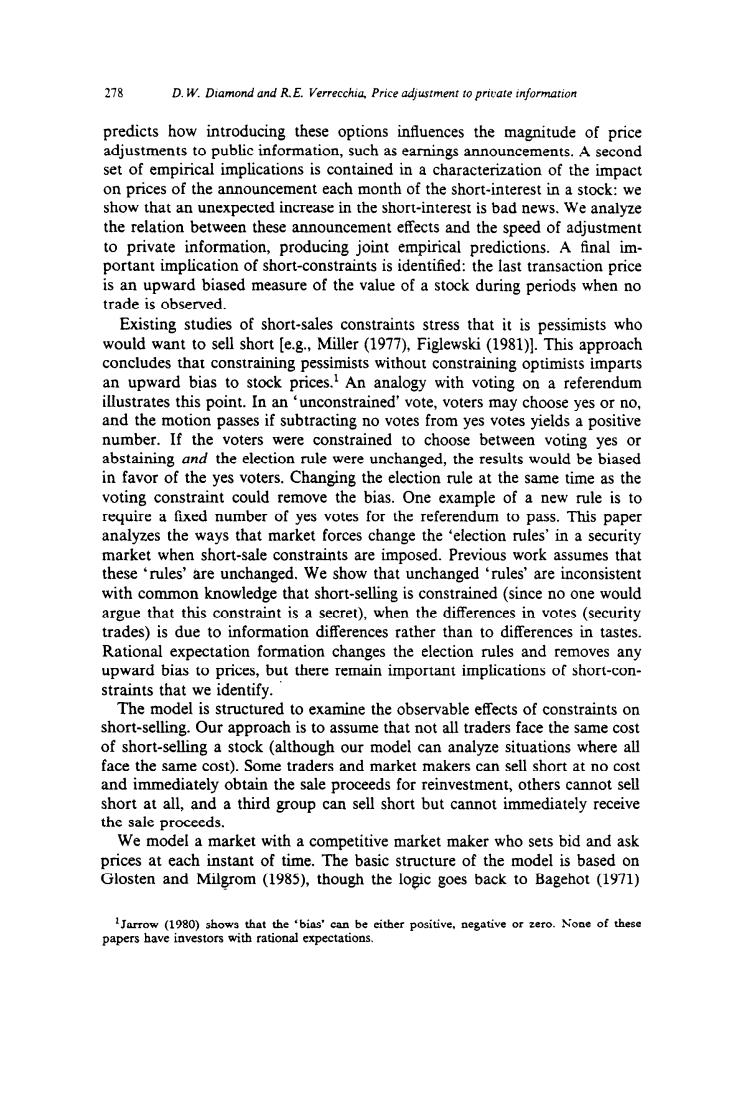正在加载图片...

278 D.W.Diamond and R.E.Verrecchia,Price adjustment to private information predicts how introducing these options influences the magnitude of price adjustments to public information,such as earnings announcements.A second set of empirical implications is contained in a characterization of the impact on prices of the announcement each month of the short-interest in a stock:we show that an unexpected increase in the short-interest is bad news.We analyze the relation between these announcement effects and the speed of adjustment to private information,producing joint empirical predictions.A final im- portant implication of short-constraints is identified:the last transaction price is an upward biased measure of the value of a stock during periods when no trade is observed. Existing studies of short-sales constraints stress that it is pessimists who would want to sell short [e.g.,Miller (1977),Figlewski (1981)].This approach concludes that constraining pessimists without constraining optimists imparts an upward bias to stock prices.An analogy with voting on a referendum illustrates this point.In an 'unconstrained'vote,voters may choose yes or no, and the motion passes if subtracting no votes from yes votes yields a positive number.If the voters were constrained to choose between voting yes or abstaining and the election rule were unchanged,the results would be biased in favor of the yes voters.Changing the election rule at the same time as the voting constraint could remove the bias.One example of a new rule is to require a fixed number of yes votes for the referendum to pass.This paper analyzes the ways that market forces change the 'election rules'in a security market when short-sale constraints are imposed.Previous work assumes that these 'rules'are unchanged.We show that unchanged 'rules'are inconsistent with common knowledge that short-selling is constrained(since no one would argue that this constraint is a secret),when the differences in votes(security trades)is due to information differences rather than to differences in tastes. Rational expectation formation changes the election rules and removes any upward bias to prices,but there remain important implications of short-con- straints that we identify. The model is structured to examine the observable effects of constraints on short-selling.Our approach is to assume that not all traders face the same cost of short-selling a stock (although our model can analyze situations where all face the same cost).Some traders and market makers can sell short at no cost and immediately obtain the sale proceeds for reinvestment,others cannot sell short at all,and a third group can sell short but cannot immediately receive the sale proceeds. We model a market with a competitive market maker who sets bid and ask prices at each instant of time.The basic structure of the model is based on Glosten and Milgrom (1985),though the logic goes back to Bagehot (1971) 1Jarrow (1980)shows that the 'bias'can be cither positive,negative or zero.None of these papers have investors with rational expectations.278 D. W. Dtamond and R. E. Verrecchia. Price adjustment to pricate tnformation predicts how introducing these options influences the magnitude of price adjustments to public information, such as earnings announcements. A second set of empirical implications is contained in a characterization of the impact on prices of the announcement each month of the short-interest in a stock: we show that an unexpected increase in the short-interest is bad news. We analyze the relation between these announcement effects and the speed of adjustment to private information, producing joint empirical predictions. A final important implication of short-constraints is identified: the last transaction price is an upward biased measure of the value of a stock during periods when no trade is observed. Existing studies of short-sales constraints stress that it is pessimists who would want to sell short [e.g., Miller (1977) Figlewski (1981)]. This approach concludes that constraining pessimists without constraining optimists imparts an upward bias to stock prices.’ An analogy with voting on a referendum illustrates this point. In an ‘unconstrained’ vote, voters may choose yes or no, and the motion passes if subtracting no votes from yes votes yields a positive number. If the voters were constrained to choose between voting yes or abstaining and the election rule were unchanged, the results would be biased in favor of the yes voters. Changing the election rule at the same time as the voting constraint could remove the bias. One example of a new rule is to require a fixed number of yes votes for the referendum to pass. This paper analyzes the ways that market forces change the ‘election rules’ in a security market when short-sale constraints are imposed. Previous work assumes that these ‘rules’ are unchanged. We show that unchanged ‘rules’ are inconsistent with common knowledge that short-selling is constrained (since no one would argue that this constraint is a secret), when the differences in votes (security trades) is due to information differences rather than to differences in tastes. Rational expectation formation changes the election rules and removes any upward bias to prices, but there remain important implications of short-constraints that we identify. The model is structured to examine the observable effects of constraints on short-selling. Our approach is to assume that not all traders face the same cost of short-selling a stock (although our model can analyze situations where all face the same cost). Some traders and market makers can sell short at no cost and immediately obtain the sale proceeds for reinvestment, others cannot sell short at all, and a third group can sell short but cannot immediately receive the sale proceeds, We model a market with a competitive market maker who sets bid and ask prices at each instant of tune. The basic structure of the model is based on Glosten and Milgrom (1985), though the logic goes back to Bagehot (1971) ‘Jarrow (1980) shows that the ‘bias’ can be either positive, negative or zero. None of these papers have investors with rational expectations